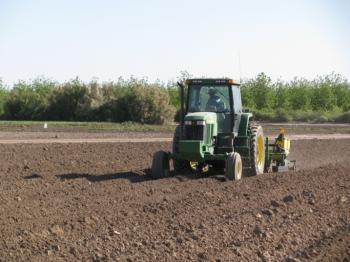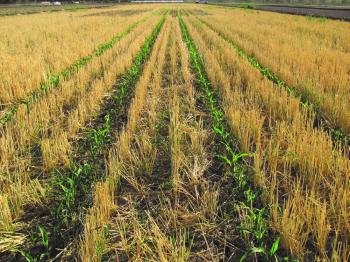Tillage Management


In New Mexico and other parts of the Southwest, reduced tillage has gained attention because of the negative effects that conventional tillage has on the environment and soil quality, as well as economic benefits associated with less intensive tillage operations.
What are the Types of Tillage?
Conventional tillage is the preferred tillage method in the region and consists of using one or more of the following practices: plowing, ripping or subsoiling, and disking and harrowing.
Reduced tillage is the reduction of soil disturbance via several tillage methods in the field during cultivation. In many cases, no-tillage is associated with reduced tillage. This is a method in which the soil is not broken up except by the incision made in the soil for seed placement.
What is the Importance of Reducing Tillage in Arid and Semi-Arid Regions?
Before introducing the benefits of reducing tillage, growers need to know the negative effects conventional tillage poses on the environment and soil quality. Conventional tillage has led to accelerated soil erosion by wind and water as well as degraded soil quality. Some of the negative effects include: reduced soil organic matter, surface crusting, soil compaction, poor soil structure, poor water and nutrient holding capacity, high carbon dioxide emissions, limited biological activities, and high susceptibility of crops to soil-borne pests and pathogens.
Reducing tillage has many benefits for dryland farmers.
- Soil erosion control. In New Mexico, strong winds occur during the early spring which coincides with the time farmers prepare their seed-beds with conventional tillage. This creates soil that is bare, smooth, and unprotected and predisposes the soils to wind erosion. Water erosion often occurs because of the short, intense rainfall that is common for arid and semi-arid climates. Reduced tillage strategies involve the retention of residue or stubble on the soil surface, which offers protection the soil from water and wind erosion.
- Soil organic matter accumulation. With intensive plow-based tillage, organic matter is exposed to soil organisms and, together with better aeration of the soil, the organic material is broken down more rapidly compared to soils that are not tilled intensively. Due to less soil disturbance while using reduced tillage methods, organic carbon will accumulate in the soil which will improve soil health and overall function for crop production.
- Soil health considerations. The increases use of tractor and equipment passes with plow-based tillage increases soil compaction. Also, the loss of soil organic matter associated with intensive tillage practices affect many other soil properties, such as the infiltration of water, soil moisture retention, soil aggregation, and overall soil fertility. Soil organism counts, like earthworms and soil microbes, are greatly affected by the disturbance that intensive tillage practices create in the soil. Reduced tillage reduces the amount of disturbance in soil which increases soil health.
- Soil moisture conservation. Water availability for crop production is particularly challenging in arid and semi-arid agroecosystems. Plants are often water-stressed due to a number of factors such as low precipitation, high temperatures, strong desiccating winds, inconsistent irrigation supplies, and poor irrigation efficiencies. Reduced tillage systems (strip tillage or no-tillage) will reduce the impacts of these factors and retain more moisture, which will ensure crop survival against short-term droughts common in New Mexico.
- Economic considerations. Fuel, labor and other costs for tillage operations constitute one of the major recurrent expenditures on the farm. With reduced tillage, fuel usage and labor hours are cut down for land preparation. For the first few years, yields may be reduced due to relatively inadequate soil conditions and weed challenges. However, in the long-term and with good management, crop yields can catch up or even become higher then conventional tillage systems. Yield and economic benefits of reduced tillage are more evident in the areas with greater drought potential.
What are Strategies for Reducing Tillage in Arid and Semi-arid Regions?
When transitioning from conventional tillage systems, reduced tillage may be a better "first step" than strict no-tillage. The adaptability of no-tillage can be difficult in some soils, and it is often problematic to go into strict no-tillage after several years of conventional tillage practices. However, it is possible to transition to no-tillage in heavy soils, although it may take a few more years to the system to maintain or improve crop yields.
Any practice that reduces the frequency or intensity of mechanical tillage can be considered reduced tillage, e.g., strip tillage, direct seeding, spraying, etc. Direct seeding of cover crops into previous cash crop residue is regarded as reduced tillage because tillage operations that turn over the soil have been removed.
Reduced tillage options that you can choose will depend on conditions such as type of crop rotation, soil type, water availability for cover cropping, finance to purchase new soil management tools and your goals for reducing tillage. It is advisable to consult your Cooperative Extension Service County Agent or agricultural consultant. Also, you should consider discussing your interest with other growers who have successfully tried different reduced tillage options in your region to learn from their experiences, successes, and failures.

What are the Challenges Inherent in Reduced Tillage Systems?
Weed control is a challenge in reduced tillage systems. It is important to plan effective ways to prevent an explosion of weeds. For the fall, using cover crops, and covering the soil surface with residue for weed suppression have been successfully used by farmers engaged in reduced tillage systems.
Soil-borne disease and pests are also a concern for reduced tillage systems. Their survival in the previous year's crop residue could affect the following cash crop. The four major strategies for battling disease or pathogen are: application of chemicals, biological control, host resistance, and cultural control. Crop rotation has been known to help with some of the pest and pathogen problems.
Low soil temperature in the spring due to surface residue cover is another challenge faced in reduced tillage systems. Lower temperatures in soil can delay spring planting and the integration of cover crops into cropping systems. If heavy residue surface residue causes lower temperature in the soil, leading to delayed crop establishment, it is advisable to use strip tillage rather than no-tillage because the seeding rows will warm up quickly in the spring.